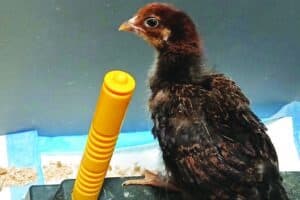Buzzing bees, a growing garden and bunny buddies. Here’s an update on happenings at Radford Ranch.I wrote recently about our return to gardening, this time with the help of a 10-foot-by-12-foot greenhouse from ShelterLogic. Our hope is that the greenhouse will keep out the hordes of grasshoppers from ravaging the garden, as they have in past years.Of course, first we had to assemble the greenhouse. The instructions assured us that a combination of two people, three hours and a few common tools was all we would need.Well, we had the two people, but instead of three hours, it took three weekends. We didn’t keep track of the hours, but I’m guessing 20 or so. We blame part of that on the instructions, which omitted a couple of facts that would have been very helpful. But part of the blame could rest with myself and Margaret; we are, after all, the same pair that once cut a hole in our door to the garage for a doggie door, only to realize that we’d cut the hole at the top of the door instead of the bottom.But we did finally get the greenhouse erected and are planting various crops. We still have some small greenhouse openings to plug, however, before the grasshoppers emerge and test our security measures.I wrote recently about the loss of our bees over the winter. Experts we consulted agreed that the bees were likely victims of the varroa destructor, or varroa mite; the mites feed on the blood of the bees and can also transmit a number of fatal viruses.It was a devastating loss at the end of our first year of beekeeping. But Margaret wasn’t ready to give up; in fact, she redoubled her efforts and we now have two beehives instead of one.The new bees came from Rocky Mountain Bee Supply. Previously, Margaret had gotten her bees in a nuc (pronounced nuke, and short for nucleus colony); a nuc is sort of a miniature hive, with a mated queen, four or five frames of honeycomb and 10,000 or so adult bees.The other way to get bees is through package bees, which is what Margaret did this time. A package of bees, the Rocky Mountain Bee Supply website explains “typically consists of a wooden or plastic box, three pounds or so of worker bees, a caged mated queen and a can of syrup for the trip.”The new bees are installed and seem to be doing fine. They are more aggressive than Margaret’s first-year bees, though. Those bees were gentle enough that she could go out in her sundress and tend to chores, such as delivering sugar water, and the bees would come out, say hi and buzz sweet nothings in her ear. With the new bees, Margaret must suit up in her protective bee gear or risk being stung. She calls the bees “vigorous.”A while back, I wrote about Lily the rabbit, whose bunny buddy had died. We were pondering then whether to find a new home for Lily that already had other rabbits or get a new rabbit to keep her company.We decided to get her a companion. We wanted a fellow female, but two trips to the Critter Swap at Big R uncovered mostly boys. We did come across a breeder whose boy bunnies seemed in fine shape and who had some girls, or does, back home. So we paid a visit the next day and picked out a doe, a New Zealand rabbit.From thebunny.com: “New Zealand is a rabbit breed that was created in the United States and not in New Zealand. It originated in California from rabbit breeds that were imported from New Zealand. Today, New Zealand is a breed recognized by the American Rabbit Breed Association or ARBA and is available in a variety of colors.”Our new bunny, as yet unnamed, is white. New Zealand rabbits are fairly large, as is Lily. And, like Lily, New Zealand females have a fatty flap of fur below the chin, known as a dewlap.We’re introducing the rabbits slowly; so far we haven’t let them freely interact, but they have rubbed noses and even stretched out next to each other while separated by a cage.I’ve also written about our tough-luck chicken, Louise. She and Thelma are among thousands of hens that were rescued from a neglect situation in Utah; they made their way to Colorado via the underground chicken railroad and we adopted them. But while Thelma has thrived, Louise continues to have problems. Early this year, she was diagnosed with mites; while near death, she struggled back to health. But recently, she became lethargic again. This time, the problem appeared to be sour crop.A chicken’s crop, located between the beak and the stomach, is where food is temporarily stored before digestion. Sour crop is an infection caused by a fungus. Bad breath and liquid dripping from the beak are among the signs. With the vet’s help, we have nursed Louise back to health yet again.Meanwhile, she has a few new roommates. At the Critter Swap, Margaret, struck by their beauty, also ended up getting three young chickens. They’re sapphire gems and they’re striking in appearance; the hens are mostly blue, typically with a ring of gold or gray around their neck. Margaret assures me they’re the last new chickens we’ll get for this egg-laying season. But to play it safe, I am hoping to keep her away from the Critter Swap for the rest of the year.






